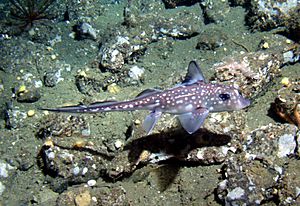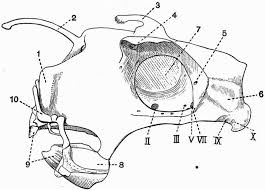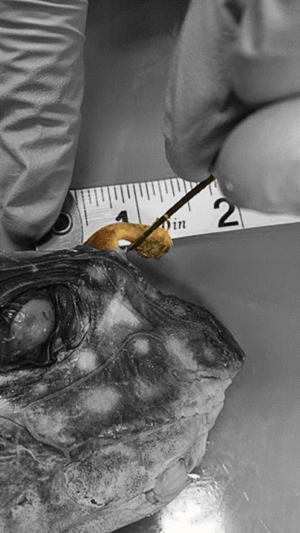Spotted ratfish facts for kids
Quick facts for kids Spotted ratfish |
|
|---|---|
 |
|
| Conservation status | |
| Scientific classification | |
| Genus: |
Hydrolagus
|
| Species: |
colliei
|
The spotted ratfish (Hydrolagus colliei) is a type of chimaera fish. You can find it in the northeastern Pacific Ocean. Divers often see these fish at night, especially in the Pacific Northwest. This cartilaginous fish gets its name from its pointed, rat-like tail.
Spotted ratfish lay leathery egg cases on the muddy or sandy seafloor. Divers sometimes mistake these egg cases for rocks or plants. While this fish usually lives in deep water, it can be found closer to the surface in the northern parts of its home range. The name Hydrolagus comes from Greek words meaning "water" and "hare." The name colliei honors Alexander Collie, an early naturalist. The spotted ratfish is common and not usually eaten by people. It is also not caught for sale.
Contents
What Does the Spotted Ratfish Look Like?
The spotted ratfish looks very different from other fish. Female ratfish can grow up to 97 cm (38 in) long. This makes them much bigger than the males. These fish have smooth skin with no scales. Their skin is a silvery-bronze color, often with shiny gold, blue, and green shades. White spots along their backs give them their "spotted" name.
Their tail and back fins have dark edges, but their side fins are clear. Their large, triangle-shaped side fins stick out like airplane wings. They have a venomous spine on the front edge of their back fin. This spine is used for defense. It does not present a serious danger to humans. However, it can cause painful wounds and has been known to seriously hurt harbor seals that try to eat them. The ratfish's tail is almost half its total length. It looks very much like a pointed rat's tail.
The body of this fish is supported by cartilage, not bone. It has a snout shaped like a duck's bill and a face that looks a bit like a rabbit's. Its mouth is small. It has one pair of front teeth on the bottom jaw and two pairs on the top jaw. Unlike sharks, which have sharp, replaceable teeth, spotted ratfish have plate-shaped teeth. These teeth are strong and permanent, helping them grind their food.
Like many bony fish, but unlike sharks, the upper jaw of the chimaera is fused to its skull. Even though their jaws are soft and mouths are small, they have a very strong bite for their size. This helps them eat large prey. One of their most amazing features is their large, emerald green eyes. These eyes can reflect light, just like a cat's eyes.
Where Do Spotted Ratfish Live?
You can find the spotted ratfish in the northeastern Pacific Ocean. Their range goes from Alaska down to Baja California. There is also a separate group in the Gulf of California. They are very common in most of these areas. You will find them most often off the Pacific Northwest.
These fish can live from the surface down to about 913 meters (3,000 feet) deep. However, they are most common between 50 and 400 meters (160 and 1,300 feet) deep. Spotted ratfish tend to live closer to the shore in the northern parts of their range. They can be found as shallow as 30 meters (100 feet) off California.
Spotted ratfish usually move to shallower water in spring and autumn. Then they go to deeper water in summer and winter. For most of the year, they like water temperatures between 7.2 and 8.9 °C (45.0 and 48.0 °F). But sometimes they move into slightly warmer water. They are most often found living near the sea floor in sandy, muddy, or rocky reef areas. Unlike most of their relatives, which only live in deep waters, spotted ratfish have been kept in public aquaria. They have also bred in these aquariums. The main things needed to keep them are low light and cool temperatures, usually 8–12 °C (46–54 °F).
What Do Spotted Ratfish Eat?
The spotted ratfish swims slowly above the seafloor to find food. They find their food by smell. They usually hunt at night, moving to shallower water to feed. They especially like crunchy foods such as crabs and clams. Besides these, spotted ratfish also eat shrimp, worms, small fish, small crustaceans, and sea stars.
Animals that eat spotted ratfish include soupfin sharks, dogfish sharks, Pacific halibut, pinnipeds (like seals), and pigeon guillemots (a type of bird).
Reproduction and Life Cycle
Like some sharks, spotted ratfish lay eggs. This means they are oviparous. Their main time for laying eggs is from spring to autumn. During this time, the female releases up to two fertilized eggs into sandy or muddy areas of the seabed every 10–14 days. The process of laying the eggs can take 18–30 hours. The actual laying can last another 4–6 days.
The egg sack is tough and leathery. It is about 12.7 cm (5 in) long. It has a thin string attached to it, which helps it stick to the ocean floor after the mother lets it go. A female might swim around her newly laid eggs. She does this hoping to keep predators from finding them. The egg can take up to a year to develop. This can be risky because divers sometimes mistake the eggs for non-living objects. When the young fish finally hatch, they are about 14 cm (5.5 in) long. They grow to about 30 cm (12 in) in length in their first year.
Male spotted ratfish have several special features for mating. These include paired pelvic claspers and a single frontal clasper (also called a tentaculum). The pelvic claspers are on the underside of the fish. They stick out from the pelvic fins. They are used to move sperm to the female's oviduct. The inside of the pelvic clasper has cartilage and splits into two parts. It ends in a soft lobe at the back.
The cephalic clasper (tentaculum) is a unique, club-like organ. No other vertebrates have it. This clasper is on the male's head, just in front of its eyes. The tip of this organ can be pulled back. It is soft and covered with many small, sharp barbs. Males use this clasper to hold onto the female's pectoral fin during mating. This helps the male stay attached. Scientists have found scars and scratches on the backs of females, which supports this idea. Males are much smaller than females, which is a sexually dimorphic trait. This size difference might be why they use this mating behavior.
How Do Spotted Ratfish Behave?
The ratfish usually stays a safe distance from divers. They are not typically aggressive. However, if they feel their space is invaded, they can use their back fin spines to give a mildly painful poke. When they swim, they do "barrel rolls" and corkscrew turns. It looks as if they are flying. Ratfish swim using their large pectoral fins, which often makes their movement look like "aquatic flight," similar to a bird.
Rare Albino Ratfish
A rare albino Puget Sound ratfish was found near Whidbey Island, Washington. It is the only pure albino among the 7.2 million specimens in the University of Washington's fish collection.
Images for kids








